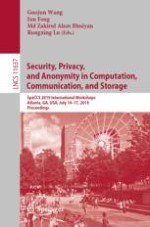2019 | Buch
Security, Privacy, and Anonymity in Computation, Communication, and Storage
SpaCCS 2019 International Workshops, Atlanta, GA, USA, July 14–17, 2019, Proceedings
herausgegeben von: Prof. Guojun Wang, Jun Feng, Md Zakirul Alam Bhuiyan, Rongxing Lu
Verlag: Springer International Publishing
Buchreihe : Lecture Notes in Computer Science
